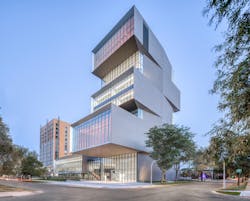University of Chicago Campus Building Shines with Zinc Panels
Chicago, Ill.
DESIGN TEAM:
Diller Scofidio + Renfro, Brininstool + Lynch
The David M. Rubenstein Forum project at the University of Chicago is located on Chicago’s Midway Plaisance and offers views of downtown Chicago, Lake Michigan, and the university campus. The vision of the architectural teams at Diller Scofidio + Renfro of New York City and Brininstool + Lynch of Chicago was to create a retreat space, which would allow for both formal presentations as well as casual meetings. The uniquely shaped building has an auditorium, a variety of meeting spaces, a dining room and an elevated wine bar and cafe. The University Room, which is the building’s largest room, seats more than 600 people theater-style.
On the exterior, vertical zinc panels were chosen to express the idea of connectivity on the façade. Zinc was favored because it is a natural and durable material that is timeless and creates its own patina which protects the material for a long time. Zinc is very flexible, which worked well with this building’s geometry, and the way it reflects sunlight was appealing to the design team. The vertical panels also accentuate the height of the building.
SOLUTION:The project utilized 60,000 sq. ft. of custom Versa-Lok—a flat shingle-style wall panel—and custom fabricated wall panels that were manufactured by ATAS in 1.0-mm gray zinc. The panels were used as exterior wall cladding on this 166-ft.-tall building consisting of 10 stories—a two-story base and an eight-story tower.
Beyond the obvious aesthetic impact, the zinc wall cladding was also selected for its sustainable design-supporting features. The Forum is targeting LEED Gold certification and using zinc wall cladding will help this project achieve its goal. Zinc is durable, resistant to corrosion and 100% recyclable, which makes it safe for the environment. It can be reclaimed and reprocessed indefinitely without significant degradation of its properties. In addition, the expected long-life span of zinc means that the wall cladding will not need to be replaced for decades. Depending on the environment, metal wall cladding can last well over 100 years, often outlasting the building itself.
This project was the first-place winner in ATAS’ 2020 Project of the Year competition, in the commercial walls category.
null